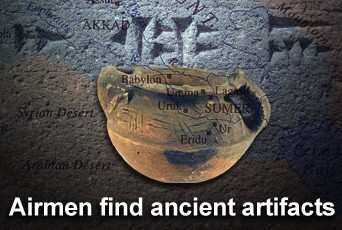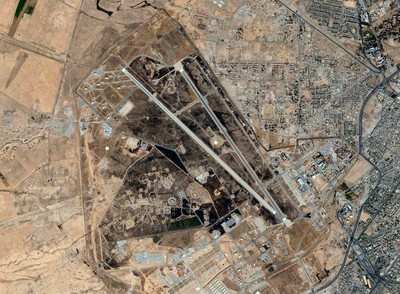 An Airman and his team discovered
fragments of pottery, possibly dating back as far back as 2,000
years during a recent job at Kirkuk Air Base. Tech. Sgt. Kelly
Wayment, a heavy equipment operator with the 506th Expeditionary
Civil Engineer Squadron here, was carrying out a routine operation
near a helicopter landing pad when he noticed something peculiar.
Sergeant Wayment was spotting for fellow 506th ECES member Staff
Sgt. Michael Massey as he drove a grader over the area.
An Airman and his team discovered
fragments of pottery, possibly dating back as far back as 2,000
years during a recent job at Kirkuk Air Base. Tech. Sgt. Kelly
Wayment, a heavy equipment operator with the 506th Expeditionary
Civil Engineer Squadron here, was carrying out a routine operation
near a helicopter landing pad when he noticed something peculiar.
Sergeant Wayment was spotting for fellow 506th ECES member Staff
Sgt. Michael Massey as he drove a grader over the area.
"I noticed something on the ground that looked kind of like a
rock," said the NCO deployed from Hill Air Force Base, Utah. "I
picked it up and saw it looked more like pottery. So we started
looking around and found more."
Much more. At that one location alone, Airmen have found more
than 100 pottery fragments. There are three additional sites on the
base where pottery fragments are being discovered, said 2nd Lt.
Brian Wernle, 506th ECES environmental engineer.
"As construction continues around the base, people are coming to
(us) saying 'we've found some more pottery,'" Lieutenant Wernle
said.
The pottery fragments were brought to Lieutenant Wernle who
sought the help of higher headquarters at U.S. Central Command Air
Forces and a local historical expert to identify and date the
pieces. Historians recognize the area around Kirkuk AB as being
home to many ancient civilizations. The Mesopotamian city of Nuzi
was located just southwest of the current base. Excavations there
in the early 20th century resulted in the finding of an archive of
more than 4,000 clay tablets inscribed with Akkadian cuneiform
script. To the east of the base lies Jarmo, long considered to be
the first agricultural community dating back as far 7,000 B.C.

Sh. A. Ameen visited the base to assist Lieutenant Wernle in
identifying the pieces and to assess whether construction could
continue or if a more extensive excavation was in order. Under
Saddam Hussein's regime, archaeologists and historians were not
allowed onto the base and had no access to anything found there,
Mr. Ameen said. Under the new relationship with U.S. forces, he
said he sees the opportunity to work together in helping to
preserve Iraq's history.
"All these things we've found belong to everybody," Mr. Amaan
said. "When Iraqis and coalition forces work together we try to
preserve the historical value of the items that we find in Kirkuk.
We want to protect this area here so everybody can enjoy the
historical artifacts. This way we can pass on this history to the
next generation."
Lieutenant Wernle, deployed from Andrews AFB, Md., also looks
forward to a closer working relationship with local historians and
is trying to implement procedures to speed up the process of
identifying any future pieces found. While remaining sensitive to
the historical significance of the area, the 506th ECES Airmen also
have to balance the mission requirements they are tasked to
fulfill.
"What we're trying to do is expedite a procedure where we can
have somebody come out, identify whether the objects in question
are artifacts and then determine whether we can continue building
on this site or halt construction and identify it as a new
archaeological site," he said. "(Ultimately) our goal is to hand
this area back to the Iraqis, so we'd like to preserve as much of
their history as possible."

The find has been a learning experience for Sergeant Wayment.
Since discovering those first few pieces, he said he has found
himself more aware of what could be under his feet.
"I've been more cognizant about looking on the ground, about
looking for more pieces -- not knowing what I could find and what
significance it could have," he said. As one of the first Airmen
literally "on the ground" when the items were found, Sergeant
Wayment said he recognizes the importance of learning a little more
about the history of the country he's deployed to.
"History is important," he said. "This land has a lot of
history. The people have been here for thousands of years. So
anything that can help us learn more about their way of life is
beneficial to everybody."
The hundreds of pieces the Airmen found are still being assessed
locally. Once age and significance are determined, Lieutenant
Wernle said he plans to get a team of experts to conduct further
investigations on both the fragments and the site. [ANN Salutes
Staff Sgt. Trevor Tiernan, US Central Command Air Force Combat
Correspondent Team]
 ANN's Daily Aero-Linx (05.06.25)
ANN's Daily Aero-Linx (05.06.25) ANN's Daily Aero-Term (05.06.25): Ultrahigh Frequency (UHF)
ANN's Daily Aero-Term (05.06.25): Ultrahigh Frequency (UHF) ANN FAQ: Q&A 101
ANN FAQ: Q&A 101 Classic Aero-TV: Virtual Reality Painting--PPG Leverages Technology for Training
Classic Aero-TV: Virtual Reality Painting--PPG Leverages Technology for Training Airborne 05.02.25: Joby Crewed Milestone, Diamond Club, Canadian Pilot Insurance
Airborne 05.02.25: Joby Crewed Milestone, Diamond Club, Canadian Pilot Insurance





